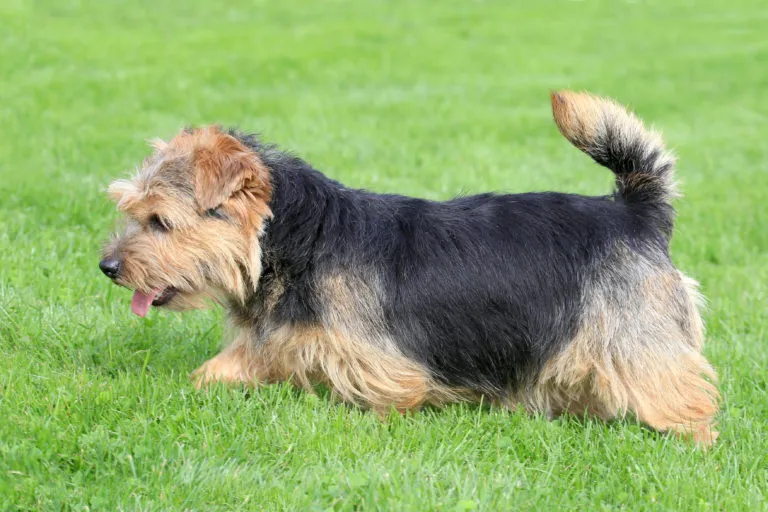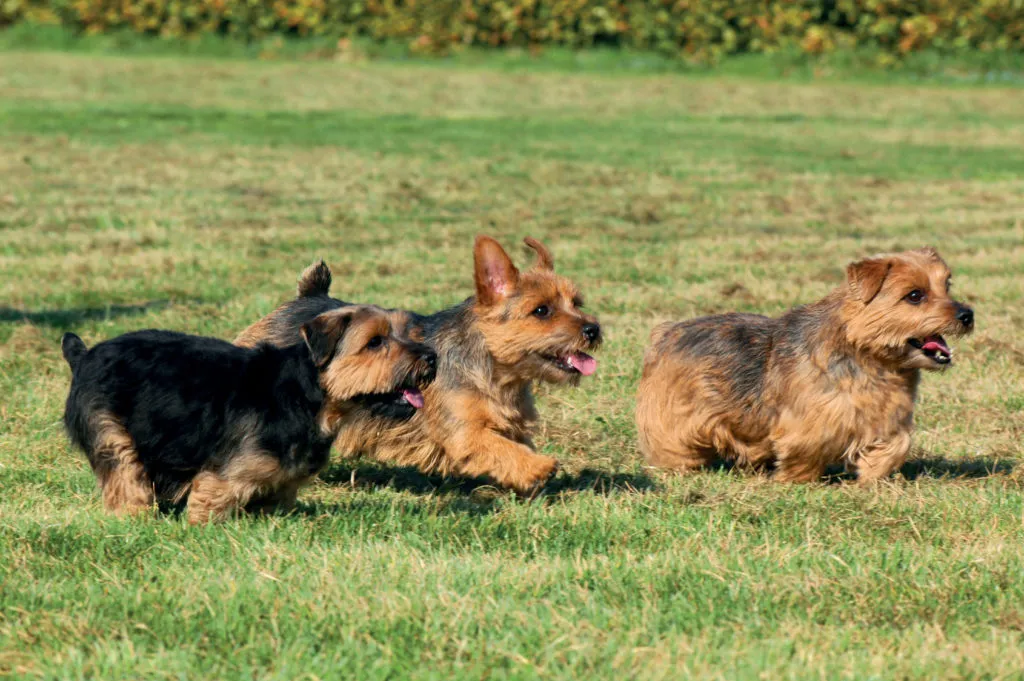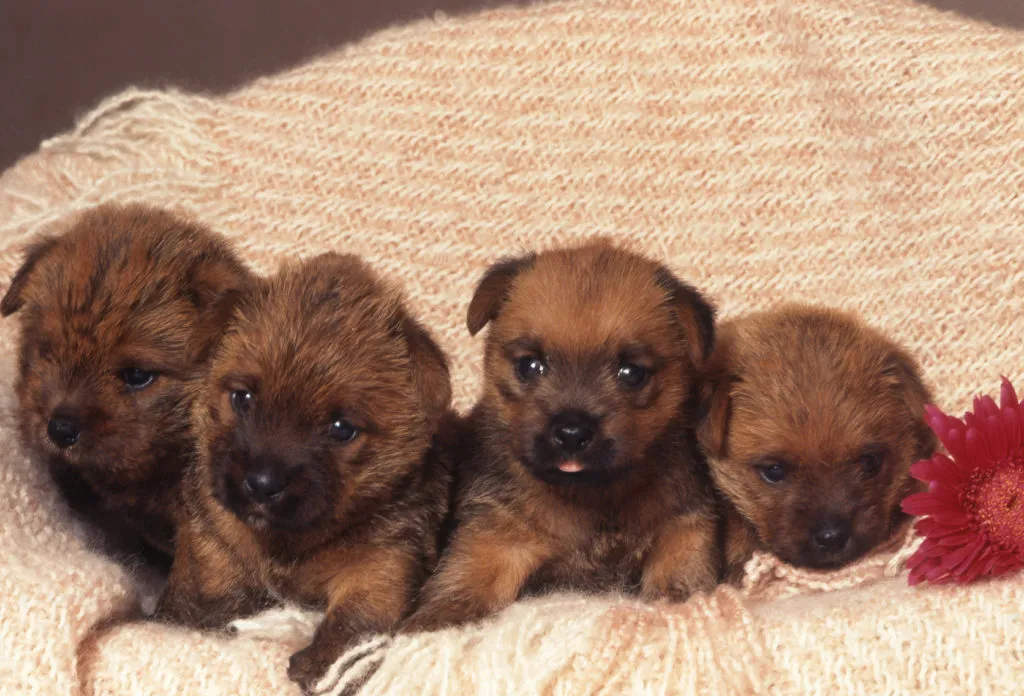Medium Size Poodle
The British Norfolk Terrier is one of the smallest Terriers, renowned for its charming and balanced nature. Initially a rat hunter, this breed is now a cherished family pet, admired for its small size and adaptability, making it an easy-going companion.

© Vincent / stock.adobe.com
Whether it’s a game of chase or a cozy cuddle session, these spirited Norfolk Terriers bring endless energy and affection to every moment
The Norfolk Terrier and the Norwich Terrier share a common history and are distinguished mainly by their ear position. They are the only Terriers specifically described in their standard as “not quarrelsome”. Unlike many other Terrier breeds, Norfolks are not aggressive and can be easily kept in groups.
These lively Norfolk Terriers love playing, romping and cuddling, whether with other dogs or people. They enthusiastically participate in activities and prove to be very enduring and adaptable. With their quick learning ability, they understand commands swiftly and usually submit willingly to their leader. Dominance tendencies, which can cause issues with other Terriers, are rare in the peaceful Norfolk.
However, this breed also requires consistent training. With its charming personality, it can easily woo its owner, leading to undesirable behaviours if training is too lax. Despite its small size, the little dog possesses a notable self-confidence, which can drive it to take charge if allowed. However, with loving and firm boundaries from the start, the intelligent Norfolk will present little difficulty.
Its friendly nature, good-natured playful character, and manageable size make it a popular companion, suitable even for families with children. However, children should treat the dog respectfully, as excessive teasing can test its patience, like with most dogs.
The Norfolk Terrier not only serves as an enthusiastic playmate and loyal companion but is also an excellent watchdog, alerting at unusual noises and fearlessly defending its family in an emergency despite its size.
 © Ricant Images / stock.adobe.com
© Ricant Images / stock.adobe.com
Standing at a mere 25 to 26cm tall and weighing 5 to 7kg, the Norfolk is undoubtedly among the smallest and lightest Terriers. However, its compact build makes it appear robust and resilient. Its short, rough fur lies close to its body, giving it a very natural and sturdy look.
The distinctive feature from the Norwich Terrier is its medium-sized, V-shaped ears that are folded forward and lie close to the cheeks, unlike the Norwich’s erect ears. The small Terrier with a short back and strong bones comes in various shades of red, wheat, black with tan, or grizzle (grey), with the red coat being the most recognised.
Healthy and robust, Norfolk Terriers can live up to 15 years. To ensure your dog remains fit and active, a balanced, healthy diet is essential. More important than the form of food – whether you choose dry or wet food, home-cooked meals or raw food – is the quality of the ingredients. These should always meet your dog’s individual needs, which can vary with its age, condition and weight.
A diet for an adult dog should include sufficient high-quality meat or fish for its essential proteins. Additionally, the dog needs fruits, vegetables and rice. If preparing your dog’s own food, remember to add essential fats like fish-oil, rich in valuable omega-fatty acids.
If unsure about your dog’s dietary needs, consult your breeder or vet. A vet can provide a precise needs overview based on your dog’s “data”. Breeders have extensive experience in breed nutrition and can offer many practical and helpful everyday tips.
The Norfolk’s rough fur is quite easy to care for. However, regular brushing is essential. Occasionally, pluck out the dead hair with your fingers. To maintain its form and look, consider professional trimming once or twice a year.
Ears, teeth, eyes and claws also require regular care and inspection. Cleaning ears and teeth, and trimming claws provide a chance to examine your pet closely and notice any changes that could indicate potential health issues early.
The Norfolk Terrier is the folded-ear variant of the erect-ear Norwich Terrier, regarded as the same breed for a long time. It was only in 1964 that the two types were separated into different breeds based on ear set. The erect-ear dogs retained the Norwich Terrier name, while the drop-ear dogs were named Norfolk Terrier, after their origin in Norfolk County, England. The distinction between Norwich and Norfolk Terriers was not made in the USA until 1979.
Until these breeds were distinguished, the history of the two small Terrier breeds was identical. Both originate from Norfolk County on England’s east coast (Norwich is a city in this county). Several English breeders in the 19th century aimed to create local Terrier varieties for different tasks, including Norfolk, primarily an agricultural region. The major problem for grain farmers was rats, rabbits and mice, which destroyed valuable crops. The small, agile and fearless Terriers were specially bred as vermin hunters to tackle this issue.
The red-brown dogs quickly gained a reputation as effective pest controllers. They even assisted in fox hunting. Some owners had several of these sought-after working dogs and travelled from farm to farm, helping farmers with pest control for a fee. Especially popular with stable owners, who wanted to keep the unwanted rodents away from barns and stables, these Terriers were predominantly bred by stable owners around 1880. Due to their excellent working abilities, friendly nature, and handy size, the Terriers soon became valued companions.
Initially, the breeding of local dogs was far from uniform, with no standard name or breed type. The results of different breeding efforts, crossing various Terrier types like Yorkshire and Irish Terriers, were alternatively called “Cantab Terrier”, “Trumpington Terrier” and were quite diverse in form and size. They were also sometimes known as “Jones Terrier”, after the English breeder and promoter Frank Jones, who exported the first specimens to the USA in 1914.
A unified approach to breeding was achieved in 1932 with the establishment of the Norwich Terrier Club in England, encompassing both erect-ear and drop-ear types. However, crossing dogs with different ear types was avoided early on, as the mixed ear set of offspring was considered unattractive. The separation of the two types in 1964 was therefore a logical step.
During World War II, when many owners had to abandon breeding, the English Colonsay kennel was the only one maintaining the breeding of drop-ear Norwich Terriers, ensuring the survival of what would become the Norfolk. In the 1950s, other English kennels joined the breed’s efforts, but it was mainly the Gotoground kennel of Esmée O’Hanlon that strongly influenced today’s breed’s appearance and nature.
Compared to other Terriers, the Norfolk is a rather rare breed today. Finding a suitable breeder expecting puppies might take some time. Additionally, only a few puppies are typically born per litter. However, if you are keen on purchasing a dog of this breed, you can use the waiting time efficiently. The acquisition of a dog should be well-thought-out and planned with all family members. Do you have enough time for a Norfolk? Who will walk the dog and take care of it if you are unavailable?
 © Callalloo Twisty / stock.adobe.com
© Callalloo Twisty / stock.adobe.com
Only once the whole family agrees and is convinced about the breed should you seek a suitable breeder. Ideally, the breeder should belong to an official Terrier Club and have ample experience with the breed. However, awards, certificates or club memberships alone are not enough. Meet the breeder in person and inspect the breeding establishment and dogs.
A conversation with the breeder will provide insights into the breed in general and specifically their animals. Do your preferences match those of the breeder, or do they focus on show dogs or robust working dogs, while you seek a cuddly, people-oriented family pet? It is crucial to have a good feeling about the breeder, considering both professional and personal interactions.
Another criterion to observe when visiting a breeder is the health care of the dogs. Were parent animals tested for hereditary diseases? Are the puppies vaccinated and dewormed? Did a vet conduct crucial health checks on the puppies? While Norfolks are considered very robust with no known breed-specific diseases, maintaining the breed’s health is important.
Although the Norfolk enjoys being active as a former rat hunter, it demands little in terms of living conditions. It can adapt easily to both small city apartments and large houses with gardens. What’s important is that it gets enough exercise and can occasionally play freely. Never underestimate its movement enthusiasm and endurance. Norfolk Terriers thrive best with active owners who enjoy hiking, cycling or horse riding and nature outings. This lively and intelligent breed also enjoys dog sports.
Regardless of what you do with your Norfolk, the key is spending time together while keeping it physically and mentally stimulated. This people-oriented breed dislikes long periods alone. However, this shouldn’t be a concern with a Norfolk Terrier: its handy size and friendly nature mean it can accompany you almost everywhere. Even on flights, the little dog can usually sit on your lap.
If you’re a fan of the Norfolk Terrier, you might also like:
Fans of the Bearded Collie agree that those who aren't familiar with this dog breed simply have to get acquainted with it. And those who have experienced how a Bearded Collie bolts across meadows with its flowing fur, how it rolls around full of energy and joy and how it attentively and observantly takes into account its owners wishes become simply addicted to this original dog breed and its unique charm.
The Goldendoodle isn't a breed, but a pairing between Golden Retrievers and Medium or Standard Poodles. Marketed as a low-maintenance dog for allergy sufferers, this hybrid is enjoying increasing popularity amongst dog lovers, similar to the Labradoodle.